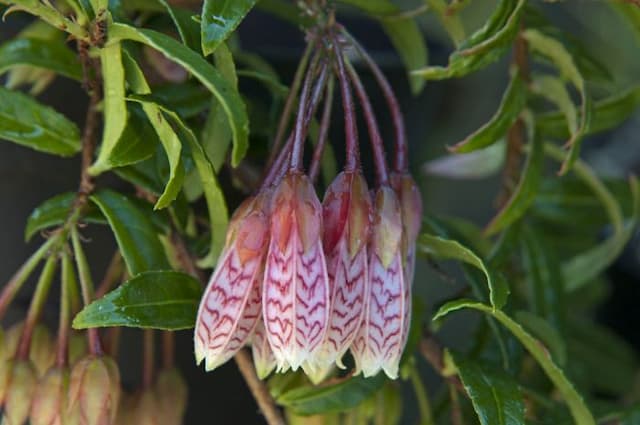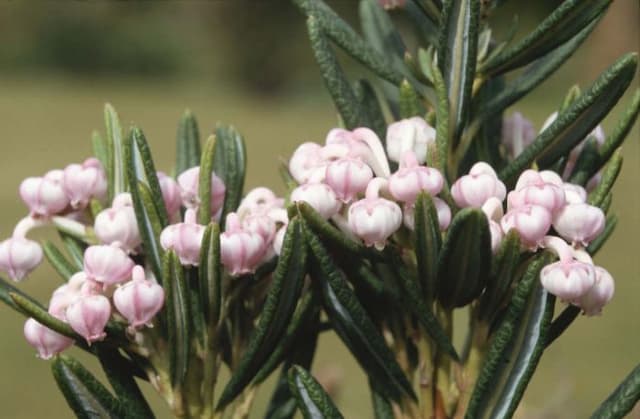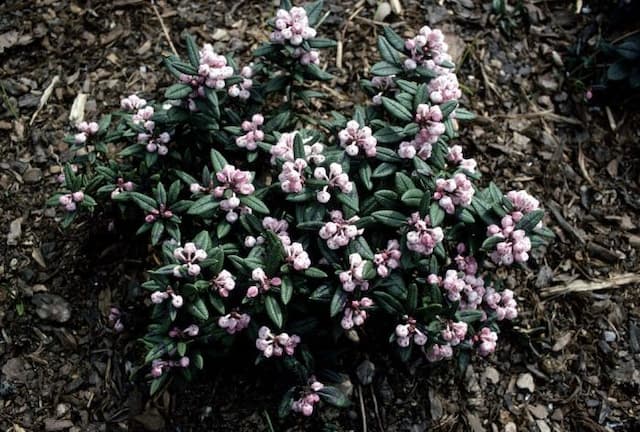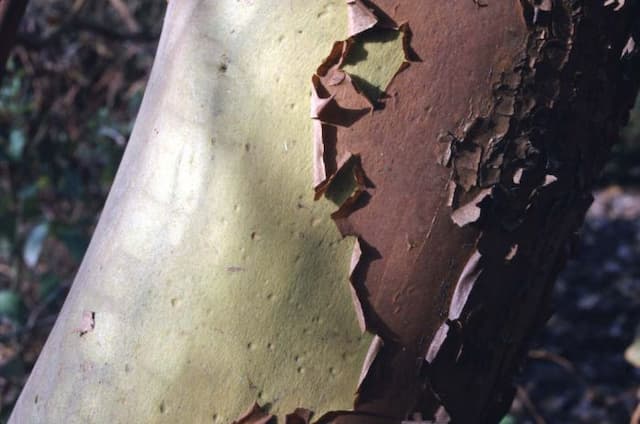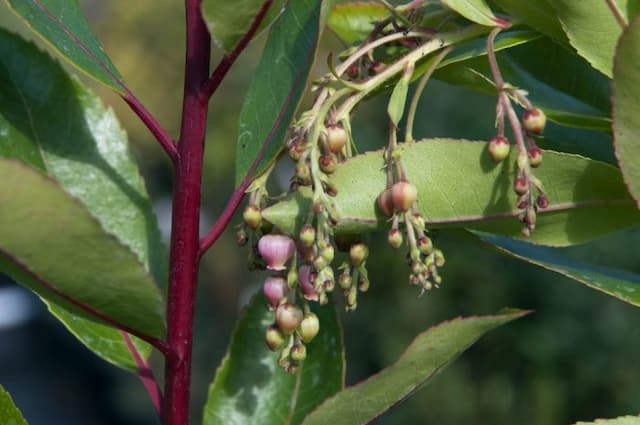Heather Calluna vulgaris 'Glenfiddich'

ABOUT
Calluna vulgaris 'Glenfiddich', commonly known as Scotch heather, is a small, evergreen shrub known for its distinctive foliage and flowers. The foliage of 'Glenfiddich' consists of tiny, needle-like leaves arranged densely along its stems; these leaves are often a gray-green or sometimes have a golden hue. During the blooming season, Scotch heather produces small, bell-shaped flowers that cluster along the tips of the upright, branching stems. The flowers can range in color from white to pink to purple, adding bursts of color to the greenery of the foliage. Being a cultivar of Scotch heather, 'Glenfiddich' may also exhibit features such as a compact habit and a robust constitution that allows it to thrive in a variety of garden settings. The overall impression is one of a delicate yet hardy plant that brings a touch of the Scottish highlands to the landscape with its textured leaves and colorful, long-lasting blooms.
About this plant
 Names
NamesFamily
Ericaceae
Synonyms
Scotch Heather, Ling, Scottish Heather
Common names
Calluna vulgaris.
 Toxicity
ToxicityTo humans
Heather is generally not considered toxic to humans. Ingesting parts of this plant typically does not lead to serious poisoning or consequences. However, as with any plant, individual allergic reactions or sensitivities can occur, and it's always prudent not to consume plant parts unless they are known to be edible and safe.
To pets
Heather is not known to be toxic to pets. It is not commonly associated with poisoning in animals such as dogs and cats. However, it's always advisable to discourage pets from eating any plant material, as gastrointestinal upset can occur from ingesting foreign matter.
 Characteristics
CharacteristicsLife cycle
Perennials
Foliage type
Evergreen
Color of leaves
Varies
Flower color
Purple
Height
1-2 feet (30-60 cm)
Spread
1-2 feet (30-60 cm)
Plant type
Shrub
Hardiness zones
5
Native area
Europe
Benefits
 General Benefits
General Benefits- Aesthetic Appeal: Adds ornamental value to gardens with its vibrant purple flowers and foliage.
- Low Maintenance: Requires minimal care once established, making it suitable for both novice and experienced gardeners.
- Drought Tolerance: Can survive in drier conditions, reducing the need for frequent watering.
- Attracts Wildlife: Provides nectar for pollinators such as bees and butterflies, enhancing biodiversity.
- Winter Interest: Retains structure and color in the garden even during the colder months.
- Soil Erosion Control: Helps to stabilize soil, preventing erosion on slopes and banks.
- Versatility: Can be used in various landscaping styles, including rock gardens, borders, and as groundcover.
- Seasonal Dynamics: Offers changing visual interest throughout the seasons with flowers in summer and fall, and foliage in winter and spring.
 Medical Properties
Medical Properties- Antimicrobial: Heather, which is the common name for Calluna vulgaris, has been traditionally used for its antimicrobial properties.
- Anti-Inflammatory: The plant is believed to have anti-inflammatory effects when used in herbal remedies.
- Diuretic: Heather has been used as a diuretic to help with urinary tract issues and kidney stones.
- Mild Sedative: It is also sometimes used for its mild sedative properties to help with sleep and relaxation.
- Detoxification: Traditionally, heather has been used for detoxifying the body and improving overall health.
- Antiseptic: It has been applied externally as an antiseptic for treating wounds and preventing infections.
 Air-purifying Qualities
Air-purifying QualitiesThis plant is not specifically known for air purifying qualities.
 Other Uses
Other Uses- The dried stems of Heather can be used as a natural broom for sweeping up leaves or light garden debris when bundled together.
- In some crafting circles, Heather branches are woven into decorative baskets or used as the frame for traditional thatching.
- Heather can be infused into oils or waxes to create fragrant candles that release a gentle, woodland scent as they burn.
- Farmers sometimes encourage Heather growth on grazing land as the flowers provide food for bees and support honey production with a distinct flavor.
- The fibrous roots of Heather can be harvested and processed to create a natural type of string or rope for garden use.
- Heather can be used in floral displays and dried arrangements to add texture and a touch of rustic charm to bouquets.
- Dried Heather flowers have historically been used for filling mattresses and pillows in rural areas as a means of repurposing plant material.
- The flowers and sprigs of Heather have symbolic meanings in some cultures and are often included in wedding bouquets and boutonnieres for good luck.
- In the art community, Heather has been used to make dyes for textiles, providing a range of colors from green to yellow-based on different parts of the plant.
- Aquarium enthusiasts sometimes use dried Heather as a natural decoration and hiding place for small fish or shrimp when submerged in tanks.
Interesting Facts
 Feng Shui
Feng ShuiHeather is not used in Feng Shui practice.
 Zodiac Sign Compitability
Zodiac Sign CompitabilityHeather is not used in astrology practice.
 Plant Symbolism
Plant Symbolism- Protection: Heather, the most common common name for Calluna vulgaris, has been considered a symbol of protection due to its widely recognized ability to grow in harsh conditions, suggesting resilience and safeguarding.
- Beauty: Heather is often associated with natural beauty as it blankets the landscape with purple and pink blooms, inspiring a sense of admiration and splendor.
- Solitude: As a plant that thrives in remote moorlands, heather symbolizes solitude and self-reflection, inviting one to embrace quiet and peaceful moments.
- Good luck: Heather has been carried as an amulet or given as a gift to impart good luck, especially in Scottish tradition where it is an emblem of good fortune.
- Admiration: With its ability to cover vast areas with its delicate flowers, heather represents admiration for the spreading of beauty and the conquering of difficult environments.
- New beginnings: The presence of heather in bloom can indicate the end of hard winters, symbolizing the beginning of new chapters and the renewal of the landscape.
 Water
WaterScotch heather should be watered thoroughly, ensuring that the soil is consistently moist but well-draining to prevent root rot. During active growth in spring and summer, water the plant about once a week with approximately one gallon of water per square yard of soil. Reduce watering in the fall and water sparingly in winter, about half a gallon per square yard of soil every two to three weeks, depending on the climate and weather conditions. Always check the soil before watering to ensure it has partially dried out.
 Light
LightScotch heather thrives in full sun to partial shade. The ideal spot offers morning sunlight with some afternoon shade, especially in regions with hot summers. Ensure it receives at least four to six hours of direct sunlight daily for best growth and flowering.
 Temperature
TemperatureScotch heather prefers cool climates and can generally withstand temperatures as low as 10 degrees Fahrenheit but begins to suffer damage below. The plant can tolerate up to around 65-70 degrees Fahrenheit without stress. The ideal temperature range for this plant is between 40 and 65 degrees Fahrenheit.
 Pruning
PruningPruning Scotch heather is done to maintain shape, encourage new growth, and promote more prolific blooming. Prune lightly in early spring before new growth starts, cutting back last year's flowering shoots to just above the fresh growth. The best time for a more extensive prune to reinvigorate older plants is immediately after flowering.
 Cleaning
CleaningAs needed
 Soil
SoilThe best soil mix for Heather (Calluna vulgaris 'Glenfiddich') is well-draining, acidic soil with a pH between 4.5 and 6.0. A mix consisting of peat moss, sand, and loamy soil in equal parts is ideal to maintain proper moisture and pH levels.
 Repotting
RepottingHeather should be repotted every two to three years to replenish the soil and provide room for growth. Spring is the best time to repot this plant to minimize stress and optimize recovery.
 Humidity & Misting
Humidity & MistingHeathers prefer moderate to high levels of humidity. Strive to maintain humidity levels around 40-60% to create the best growing conditions for the plant.
 Suitable locations
Suitable locationsIndoor
Place in bright, indirect light, with good airflow and cool temps.
Outdoor
Full sun to partial shade, protect from harsh winds and hot sun.
Hardiness zone
4-7 USDA.
 Life cycle
Life cycleCalluna vulgaris 'Glenfiddich', commonly known as Scotch Heather, begins its life cycle from seed germination in well-drained, acidic soil in which the tiny seeds develop into seedlings. The plant then enters a vegetative stage, creating a dense, bushy habit with needle-like leaves, thriving particularly well in full sun to partial shade. During the summer to fall, Scotch Heather produces small, bell-shaped flowers that may attract pollinators and can provide a range of colors from white to pink to purple. After pollination, the flowers will develop into small seed capsules, releasing seeds for the next generation when matured. Throughout its life, this perennial shrub will undergo periods of growth and dormancy, with the plant typically slowing or ceasing growth during colder months. With proper care, Calluna vulgaris 'Glenfiddich' can live for several years, sometimes up to a decade, and may become woody with age, requiring periodic pruning to maintain shape and encourage new growth.
 Propogation
PropogationPropogation time
Late summer to autumn
For Calluna vulgaris 'Glenfiddich', more commonly known as Scotch heather, the most popular method of propagation is by semi-hardwood cuttings. This technique is usually carried out in late summer. To execute this method, a gardener takes cuttings of about 4 to 6 inches (10 to 15 centimeters) in length from the current year's growth. These cuttings should contain several leaf nodes. The lower leaves are removed, and the base of the cutting is dipped in rooting hormone to encourage root development. The prepared cutting is then inserted into a well-draining rooting medium, such as a mix of peat and perlite. The environment should be kept humid, and the cuttings should be placed in indirect light until roots have developed, after which they can be potted up individually.
